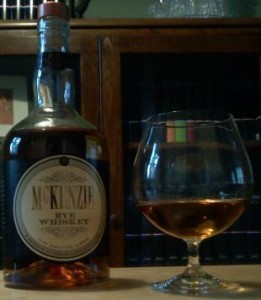McKenzie Rye Whiskey Review
By S.D. Peters
Rating: B

from Finger Lakes Distilling
(Credit: S.D. Peters)
Referring to the small, independent distilleries cropping up in the wake of the high-end cocktail boom as “micro-distilleries” downplays the larger importance of these small distillers in the American Whiskey industry. Worse, however, is calling them “boutique distilleries”. True, the dedication of these distilleries to the art of distillation is highly specialized, and the rewards of sampling them cost more than either your entry level or moderate whiskey – yet “boutique” lends them a certain exceptional air that borrows more from the elitist cache of synonyms than the extraordinary.
I can’t speak for the distilleries themselves (a few pride themselves on serving a premium audience at a premium cost), but for myself, I prefer to think that these distillers are driving whiskey in a bold new direction. They occasionally glance back at tradition, as any attentive distiller would, but prefer the view of the open road ahead.
That road may well lead to a progressive change in the whiskey experience – one that will invite more folks to experience and enjoy the age-old craft in new, inviting ways. The interest in mixology has already called attention to a long-ignored American Whiskey classic, Rye, and progressive distilleries (as I’d prefer to call them) are striving to reap the benefits with exciting innovations. Though the short term may find them struggling as the demand for Rye continues to outpace their ability to supply, these small distilleries may yet enjoy the long term benefit of a more reasonable, but steady, demand as the Rye craze levels off (a likely outcome, as a craze, like any revolution, eventually gives way to the status quo), and Rye resumes its place as a favorite American whiskey.
That may all sound a bit disingenuous coming from someone whose previous Rye whiskey reviews veer toward traditional favoritism, but the more I sample the adventurous experiments in Rye distillation, the more I find it’s possible to keep what’s best about traditional Rye without necessarily keeping it in the vanguard. The spiciness that neat Rye drinkers savor in their whiskey of choice, can be found hiding in corners, lurking in the shadows, or otherwise wrapped in an array of contrary flavors, in the Ryes distilled by progressive distillers.
Finger Lakes Distilling, in Burdett, NY, is one such progressive distiller keeping company (and competition) with the new breed. Launched in 2007 by Brian McKenzie of Elmira, NY, and Thomas Earl McKenzie of Monroeville, AL (who are “related” only in the brotherhood of craft distilling), Finger Lakes has a rather extensive catalog for a new-comer. One of their products is, not surprisingly, a Rye Whiskey.
The Rye
Finger Lakes Distilling describes their process as starting “with fermentation much like a winery or brewery” – most likely a process hit upon by Master Distiller Thomas Earl McKenzie, who counts wine-maker and brewer among his former professions. The fermented liquid is heated, and re-condensed into a higher proof spirit. “By altering the raw material used,” they say, as well as “the proof to which we distill, and the aging process, we are able to put together our wide range of products.”
McKenzie Rye Whiskey is one such product. It is a notably young Rye, aged “in new charred oak quarter casks and finished in sherry barrels from local wineries.” The difference the latter factor imparts on the taste of this Rye is significant, and not altogether undesirable.
In the glass, the amber is bit lighter than you might expect from a Rye, and the nose is striking. A touch of thyme and newly mown grass swirl around the edges of ripe mango, vanilla, and berries. The sweetness is predominate at first, but let it linger and the spice gains prominence.
A taste reveals that the sweet-to-spice progression is carefully planned. An initial sweetness lounging in a mid-weight Hound’s tooth of blackberry and apricot warms into crushed thyme and cardamom. The finish, smooth and long, trips through a meadow of vanilla, butterscotch and apricot, into a garden at the far end, where Apricot and cardamom linger.
Be warned, however: McKenzie Rye can be mischievous! The notes you discover in the nose, taste, and finish may seem miles apart, depending on what you’ve eaten before you try it. My first experience followed an hour after a salty snack of aged cheese and rosemary crackers; my second about 30 minutes after a handful of cashews. Both times, the tasting was less than spectacular, the subtle spiciness that lurks everywhere in this Rye smothered by its sweet overtones.
It wasn’t until I indulged in a mildly sweet vanilla cupcake that the Rye really revealed itself. Tasting the whiskey about 20 minutes later, I was awakened to the hidden spices that await to reward the dedicated Rye drinker. The lesson (one true of many Ryes produced by progressive distillers): Never judge by the first, or even the second taste. The third may very well be the charm.
The Price
Unlike other progressive distillers, Finger Lakes Distilling has a rather wide variety of spirits, including several whiskeys other than the Rye, such as Vodka, Gin, and several liqueurs. Like other progressive distillers, Finger Lakes Distilling spirits lack wide distribution and availability. At the time of publication, it’s possible to find them outside of New York… if you happen to live in Illinois or New Jersey. (My sister recently purchased a bottle from a distributor near Somerville, NJ.) If you find a bottle, don’t let the $39 cost dissuade you. This is a bottle of progressive Rye worth trying.
Awards
McKenzie Rye Whiskey was awarded 2012 Good Foods Award for Spirits, and The Whiskey Reviewer expects more will follow. The whiskey is also the rye of choice for Manhattans at the Jean Georges group of restaurants in New York City.





Try the Rye with a bit of Maple Sap or maple Syrup water.